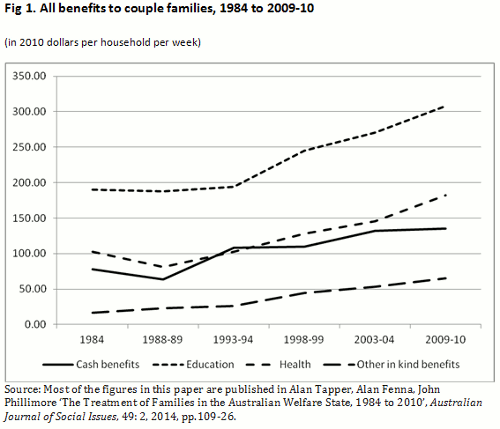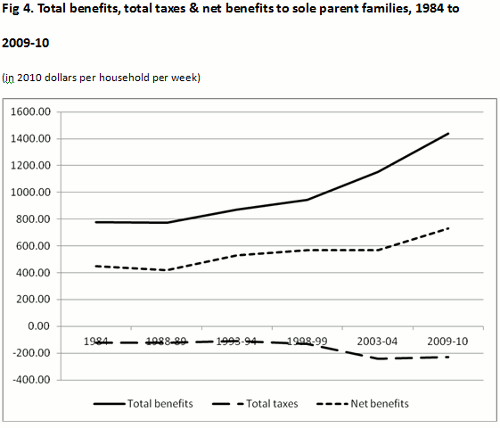In the 1980s, Australian politicians set out to make Australia a family friendly country. Those efforts have been sustained ever since, by governments of various complexions, led by Prime Ministers Hawke, Howard, and Rudd. Howard, in particular, was one of the most pro-family leaders in any modern polity. But, I will argue, these attempts have been unsuccessful. The Australian welfare state has evolved in ways that are not family friendly. The attempt was worthy, but the result is disappointing and the way forward is unclear.
My argument is based on fiscal incidence analysis—that is, in the tracking of social expenditure and household taxation across time. We are very lucky to have excellent ABS data going back to the 1980s. The big advantage of fiscal incidence analysis is that it tracks trends at the household level, and is thus independent of demographic factors. Those ABS figures show that the pro-family rhetoric was backed up by action.
Figure One shows the trendline. Support for couple families (whether through payments or taxation) did suffer a fall in the 1980s, but thereafter it was steadily increased, so that from the lowest point to 2010 there was a doubling in cash assistance to couple families. Education expenditure per household rose by 60 per cent in the 20 years between 1988-89 and 2009-10. Health expenditure more than doubled across 26 years. And ‘other in kind benefits’, including child care, though the smallest category, more than tripled. The trend was upwards in all departments of social expenditure.
Advertisement

It looks as though the action is as impressive as the pro-family rhetoric. But, unfortunately, this is not the whole picture. Too often social debates neglect the taxation side of the equation, yet it is obvious that taxation trends might negate expenditure gains. Figure Two shows the whole equation. It is a very different picture. In short, it shows that taxes on couple families have risen at almost exactly the same rate as expenditures have grown. Total taxes rose by 70 per cent; total expenditures rose by 79 per cent. The crucial indicator is the net benefits trendline. Net benefits in 2009-10 are exactly where they were in 1984—that is, they are zero. Everything that couple families get from government is fully paid for in their taxes. By this reckoning, there has been no gain on average, despite the considerable efforts of governments to follow through on their pro-family promises.

This is not quite the whole story. There have been some net gains for low income couple families.Figure Three shows the trend in net benefits by gross income quintile. It shows that low income families have gained, while high income families have lost. The gains at the low income end have been achieved by taxation increases at the higher end. Net taxes on top quintile families have more than doubled. Net benefits for bottom quintile families have also doubled.

So far I have only been discussing couple families, which today make up about 81 per cent of all families with children. Sole parent families make up the remaining 19 per cent. What do the fiscal incidence figures show about sole parent families? Figure Four shows that both taxation and expenditure have risen but the two do not cancel out, as they do for couple families. The gain in net benefits is about 60 per cent. It rises steadily, independent of the party in government.
Advertisement

Support for sole parent families has always been controversial, yet it has grown steadily despite that. Welfare dependency amongst sole parent families – mostly female sole parents -- has always been high since the 1970s, but it has trended down somewhat over time. One crucial discovery made in this period was that sole parent welfare dependency is not usually short-lived. When all episodes of dependency are taken together they sum to a large figure, around 12 years on average according to R.G. Gregory and E. Klug (in a 2003 paper entitled ‘A Picture Book Primer: Welfare Dependency and the Dynamics of Female Lone Parent Spells’. That figure was based on 1990s data, and it may be lower today. I suspect that that finding played a large part in persuading politicians of both major parties that sole parents could and should become more self-supporting. The ‘welfare to work’ program, begun in 2006, originated with the Howard government which limited sole parent payments to those with children under age 8. New welfare applicants with no child under 8 had to seek work. It was carried further under Julia Gillard in 2012, who extended it to all sole parent welfare recipients with no child under 8, not just new applicants. However different their views on other ideologically-charged issues, Howard and Gillard were in agreement on this. Yet, despite this reduction in dependency, in 2009-10 net benefits for sole parents were rising faster than ever.
What does all this fiscal analysis show? It shows, I think, three things. One, that efforts to support couple families have had no effect, except to impose more redistribution within the population of families. Two, that while couple families have on average made no gains, sole parent families have gained at a steady rate. Three, that almost none of this is driven by party political differences. The trends seem to be driven by something other than politics and ideology, though what that might be I have no good idea.
Dr Alan Tapper is Senior Research Fellow at the John Curtin Institute of Public Policy, Curtin University, Perth. The views expressed in this paper are his own, not those of the JCIPP. A longer version of this paper was presented at National Marriage Day, Parliament House, Canberra, on August 27, 2014.
Discuss in our Forums
See what other readers are saying about this article!
Click here to read & post comments.
10 posts so far.